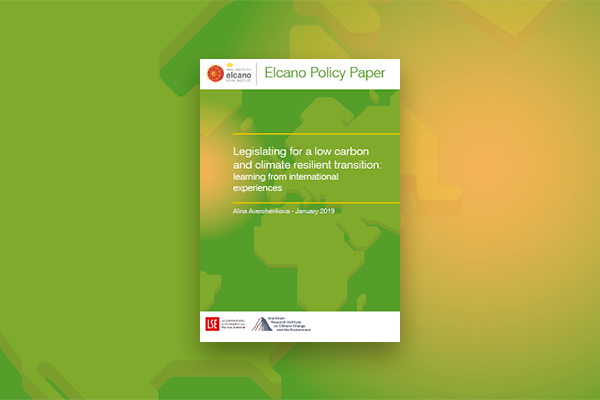Read the Executive Summary (2.4MB – PDF)
Leer resumen ejecutivo Legislando para una transición baja en carbono y resiliente al clima: aprendiendo de las experiencias internacionales (2.8MB – PDF)
Summary
The objective of this working paper is to inform policy experts, legislators and decisionmakers on the recent trends in climate change policy-making around the world and to draw lessons learnt from the experiences with designing and implementing climate change legislation. The study in particular aims to contribute to the current debate in Spain on a draft climate change and energy transition law, as well as aid other countries currently working on climate legislation.
Contents
Introduction and acknowledgements
Executive summary
Part 1. Drivers and global trends in low carbon and climate resilient transition
1. Key drivers of the low carbon and climate resilient transition
2. Global trends in legislating for low carbon transition
3. Building blocks for climate legislation and national governance frameworks
Part 2. Case studies on climate and energy transition laws and executive frameworks
4. The UK’s Climate Change Act of 2008
5. Mexico’s General Law on Climate Change and the Energy Transition Law
6. France’s Energy Transition for Green Growth Law
7. Climate change frameworks in China, Chile, Germany and the US
Part 3. Learning from experiences with climate and energy transition laws and executive frameworks
Recommendations for Spain and other countries for designing framework legislation on climate change
Introduction and acknowledgements
The objective of this working paper is to inform policy experts, legislators and decisionmakers on the recent trends in climate change policy-making around the world and to draw lessons learnt from the experiences with designing and implementing climate change legislation. The study in particular aims to contribute to the current debate in Spain on a draft climate change and energy transition law, as well as aid other countries currently working on climate legislation.
The report is structured in three parts. Part 1 provides an overview of the overall drivers for low carbon and climate resilient transition and the global trends on climate action and identifies the key building blocks of the climate governance frameworks that are important in the design of climate legislation. Part 2 reviews country experiences with designing and implementing climate change and energy transition laws and the executive frameworks in Chile, China, France, Germany, Mexico, the UK and the US. Part 3 draws lessons learnt from the comparative analysis of the case studies on the key elements of a comprehensive climate change law and provides recommendations for policy-makers. Through comparing the insights from each of the case studies the paper draws conclusions on the key considerations that should be addressed in the development of framework climate change and energy transition legislation.
The analysis draws on the latest existing studies assessing the experience with and performance of the legislative instruments in question complemented by assessing the texts of the laws. In this context the study has benefited from the author’s previous work on the UK’s Climate Change Act in collaboration with Sam Fankhauser and Jared Finnegan, and on Mexico’s General Law on Climate Change in collaboration with Sandra Guzman. The case study on France draws upon a recent an in-depth analysis conducted by Andreas Rüdinger.
The author is grateful to several policy experts who have kindly provided contributions on Chile’s climate change policy through informal interviews; to Gonzalo Escribano, Lara Lázaro and Dimitri Zenghelis for detailed review comments. The author also thanks Francisco Trincado for designing the visuals and Miguel de Avendaño, Juan Antonio Sánchez, Virginia Crespi de Valldaura, Luis Lázaro and María Dolores de Azategui for editing the paper. Finally, the author would like to gratefully acknowledge the support and contributions of José López-Tafall and his team at Acciona.
Executive summary
The urgency of action. Climate change is one of the most pressing issues for global and national development agendas. With the last 19 years having contained 18 of the warmest ones on record globally, the urgency to address both the causes and impacts of climate change is clear. According to the Fifth Assessment Report (AR 5) by the Intergovernmental Panel on Climate change (IPCC) for a likely chance of more than 66 per cent of keeping the global mean temperature increase below 2°C, global emissions of all greenhouse gases need to be net zero by 2100.
The economic and commercial case for accelerated low carbon transition is strong. Reaching the target of net zero emissions globally by the end of the century is technically and economically feasible but requires urgent action. The rapid technological change and the falling costs of the key low carbon technologies over the past two decades provide a solid foundation for accelerated decarbonisation. Ambitious action on climate change could yield direct a economic gain of US$26 trillion in 2018-2030 period compared with a business-as-usual scenario according to recent analysis by the New Climate Economy project. Most of the policy and investment decisions shaping the next two decades will be taken over the coming 2-3 years, which makes it a critical period for adopting appropriate policy frameworks.
Scaled-up action requires overcoming barriers to the low carbon transition. Barriers to low carbon investments can be addressed through price and policy signals, as well as mitigated through lowering or sharing the investment risks. Carbon pricing instruments, which now cover around 20 per cent of global greenhouse gas emissions in over 46 countries2, have been shown to be particularly effective in improving viability of low carbon investments. The growing development of new financial instruments, such as green bonds, and the recent advances in the financial regulation on sustainable finance and risk disclosure, are further driving investment towards more sustainable technologies.
Shifts in the international policy landscape require ambitious national action. The adoption of the UN Sustainable Development Goals and the Paris Agreement on climate change in 2015 have set the goal for the global transition to net zero emissions in the second half of this century. Achieving these goals requires not only successful domestic implementation of the current emission pledges, but also a major political transformation in how countries approach climate action and define their ambition. Domestic framework climate change legislation comes to the forefront as the key means to consolidate political support for the climate agenda, to provide the framework for implementation of the Paris Agreement and for assessing progress, as well as to enable ratcheting-up of ambition going forward.
National climate change legislation and policies have grown twenty-fold over the past 20. years, with a remarkable growth in developing countries in recent years. Over time the attention has shifted from putting in place framework climate legislation or strategies for the articulation of greenhouse gas emission targets. In 2017 over 70 per cent of global greenhouse gas emissions were covered either by nationally binding climate legislation or by executive climate strategies with a clearly designated coordinating body, while climate legislation alone covered 44 per cent of emissions and 36 per cent of the population (Lacobuta et al. 2018).
Domestic laws and policies are not yet consistent with international commitments. Most countries need to align their domestic emission targets, enshrined in domestic legislation, and those committed through the nationally determined contributions (NDCs) to the Paris Agreement. In order to meet these targets and to be able to ratchet them up in the future, countries need to put in place strong domestic institutional frameworks and policies.
Framework legislation can help maintain policy continuity and enable implementation. The examples of countries considered in this study demonstrate a variety of approaches to national climate change policy and that there is no one size fits all. Putting policy into law with a strong Parliamentary oversight for implementation helps reduce the scope for backtracking and provides a mandate for policy-makers to advance action. The case studies on Mexico and the UK show that climate legislation has improved the quality of the political debate and helped maintain and strengthen the political consensus on and commitment to the long-term climate objectives through turbulent political times. The case of the US demonstrates how the lack of climate legislation can make climate policy extremely vulnerable to a change of leadership. There are clear advantages for embedding the core elements of the national climate change framework into a legislation for countries like Spain, with a long democratic tradition and limited scope for centralized policy-making by the national government.
The adoption of climate change legislation requires building political support. Developing a positive narrative around the benefits of climate change legislation and creating political momentum are key for passing a law. A positive narrative also helps avoid polarisation of the political debate as was the case in the US. Integrating climate change objectives with economic and social ones and linking the legal framework with a country’s self-interest, development priorities and opportunities or co-benefits of climate action, such as in the example of China, have shown to be effective in getting political and public support for climate policy. Furthermore, following an inclusive process of cross-party development of the key features of the legislation and strong ownership by civil society through stakeholder consultation, as well as personal leadership from the country’s leader, have shown to be effective in getting political buy-in for the legislation in Mexico, the UK, California, France and Germany. Consecutively cross-party and citizen support are the best shields against the risk of reversal of the legislation.
Scope of the law and the level of specificity in prescribing policies is one of the first critical decisions that need to be taken when developing a new legislation. A flexible approach, as in the UK and California, that delegates the choice of specific policies to meet the targets to the government could offer greater political acceptability for the law and flexibility to adjust the course based on changing economic conditions and lessons learnt. However, this model requires that clear institutional processes and statutory timelines for how and when the government should develop the detailed policies are specified in the law backed by strong parliamentary oversight and provisions for an independent review by an advisory body.
Alina Averchenkova
Distinguished Policy Fellowand the lead for the Governance and Legislation research theme at the Grantham Research Institute on Climate Change and the Environment and CCCEP at the London School of Economics | @averchenkova



